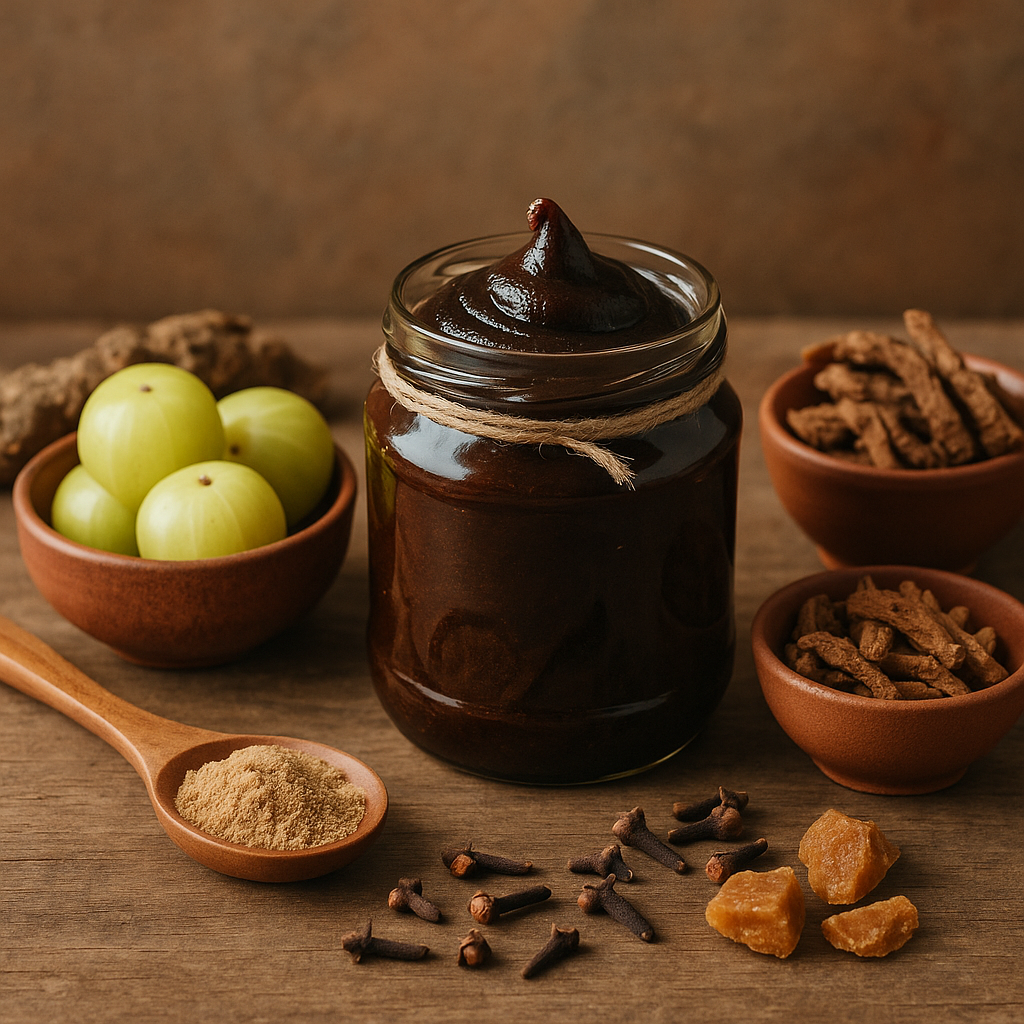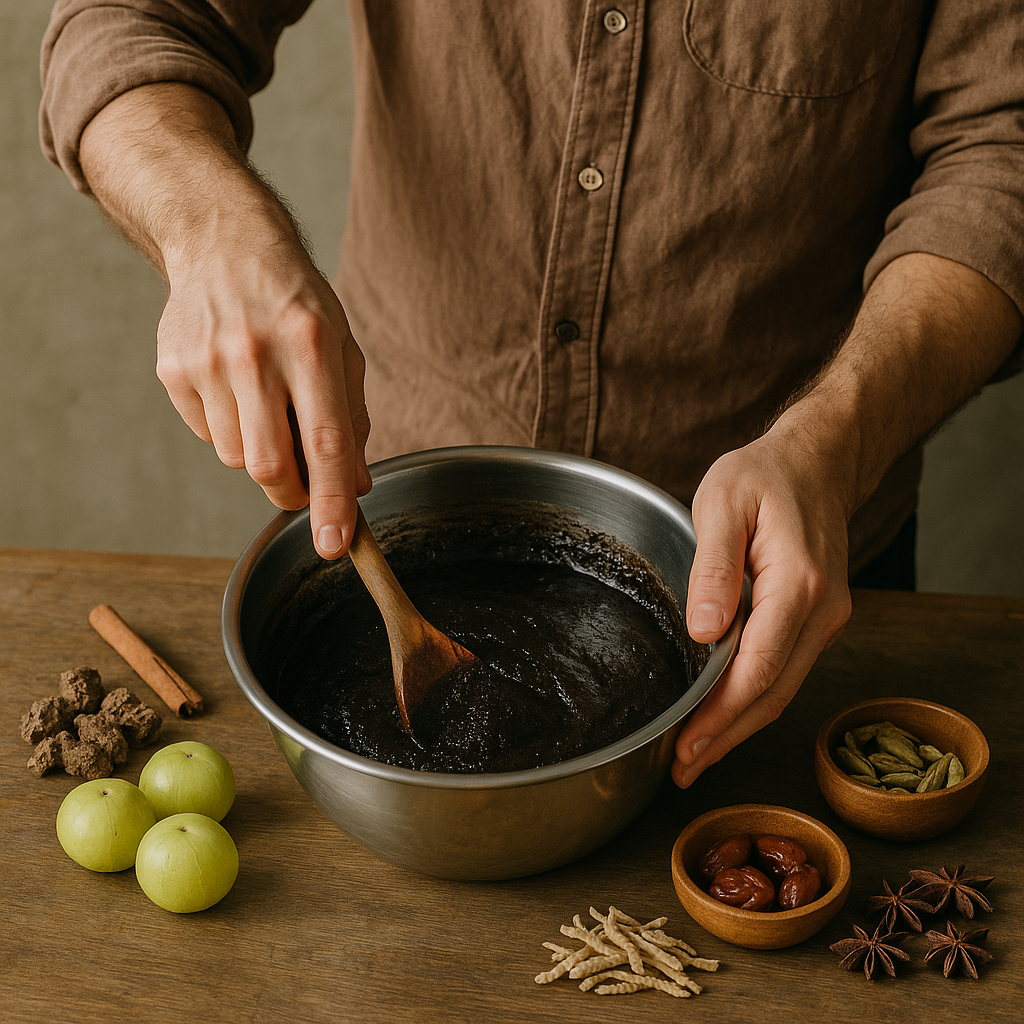Ask Ayurvedic doctor a question and get a consultation online on the problem of your concern in a free or paid mode. More than 2,000 experienced doctors work and wait for your questions on our site and help users to solve their health problems every day.
Shop Now in Our Store
How to Make Chyawanprash at Home: Traditional Recipe and Ingredients

If you've ever wondered how to make chyawanprash at home, you're not alone. With growing interest in natural immunity boosters and age-old remedies, homemade chyawanprash is gaining serious popularity. Not only does it offer a more authentic taste than store-bought versions, but it's also free of preservatives and unnecessary fillers. Learning how to make chyawanprash gives you control over what goes into your body—and it honestly just feels good making something so ancient and beneficial with your own hands.
In this detailed guide, we’ll walk you through every step of the process: the traditional chyawanprash recipe, the vital chyawanprash ingredients, and the Ayurvedic principles behind its preparation. Whether you're a complete beginner or someone who loves experimenting with holistic wellness, this post will teach you how to make chyawanprash at home the right way. Let’s get started.
What Is Chyawanprash and Its Role in Ayurveda
Chyawanprash is a time-honored Ayurvedic formulation made using a wide variety of herbs, spices, and ghee. Its origins are traced back to ancient texts, where it was crafted by the sage Chyawan to rejuvenate his body and prolong his life—hence the name chyawanprash.
In Ayurveda, chyawanprash is considered a rasayana—a rejuvenator that enhances vitality, strengthens the immune system, supports respiratory health, and promotes longevity. It's also used to balance the doshas (Vata, Pitta, and Kapha), making it a widely respected tonic for overall well-being.
What makes chyawanprash truly unique isn’t just the list of exotic herbs—it’s the process. Preparing it properly requires time, care, and the right sequence of steps to unlock the full power of each ingredient.
Chyawanprash Ingredients
Before diving into the chyawanprash recipe, it’s important to get familiar with the key ingredients of chyawanprash. While there are many modern variants, the traditional recipe includes over 30 ingredients. Don’t worry—you can simplify it for home use without losing its core benefits.
Here are the essentials:
-
Amla (Indian gooseberry) – the star ingredient, packed with Vitamin C and antioxidants.
-
Desi Ghee – aids in nutrient absorption and digestion.
-
Raw Honey – used after the paste cools, to preserve enzymes.
-
Jaggery (or organic cane sugar) – for sweetness and energy.
-
Pippali (long pepper) – supports respiratory and digestive function.
-
Guduchi (Giloy) – an adaptogen known for immunity-boosting effects.
-
Ashwagandha – for stress relief and strength.
-
Cardamom, cinnamon, cloves – for taste and additional healing properties.
-
Dashamoola – a group of ten roots used in Ayurvedic medicine (optional but powerful).
-
Bamboo manna (Vanshlochan) – for respiratory support.
-
Sesame oil or ghee – used for sautéing.
Depending on availability, some people substitute or omit hard-to-find herbs. That’s totally fine—the goal is to create a nourishing blend, not get overwhelmed chasing 40 rare roots. The beauty of the chyawanprash ayurveda approach is that it can adapt to what you have.

Step-by-Step Chyawanprash Recipe to Make at Home
Ready to roll up your sleeves? This chyawanprash recipe ayurveda style is broken down into simple steps, so even first-timers won’t feel lost.
Step 1: Prepare the Amla Base
Start by washing and steaming 1 kg of fresh amla. Once soft, remove the seeds and mash or blend into a smooth pulp. If you're using dried amla powder, rehydrate it in warm water for an hour before blending. Be sure not to skip this part—the amla base is what gives homemade chyawanprash its punch.
Step 2: Make the Herbal Decoction
This is where the soul of your chyawanprash comes alive. In a deep pan, combine about 1 liter of water with your dry herbs—this includes pippali, guduchi, ashwagandha, and whatever else you’ve chosen from the traditional chyawanprash composition. Simmer the mixture on low heat for 1 to 2 hours, allowing the liquid to reduce by half.
You're essentially extracting the essence of the herbs here, so don't rush it. You’ll want to keep the pot uncovered and stir occasionally. The aroma that fills your kitchen? Yeah, that’s when you know it’s working.
Once the decoction has cooled slightly, strain it using a muslin cloth or fine strainer. Discard the herbs, and keep the concentrated liquid—it’s now your magical elixir.
Step 3: Mix Herbal Extracts and Sweeteners
Now comes the fun (and sticky) part. In a heavy-bottomed pan, combine your amla pulp with the herbal decoction and jaggery or cane sugar (about 500g to 700g depending on how sweet you like it). Cook this on medium-low heat, stirring continuously to avoid burning.
This stage takes time—sometimes 30 to 40 minutes—so patience is key. You’re looking for the mix to thicken into a paste-like consistency. Stirring also helps the flavors to bind evenly, and yes, you’ll be tempted to taste it already, but hold off! We're not done yet.
When it starts to bubble thickly and leaves the sides of the pan, lower the heat and add ghee (4–5 tablespoons), spices like cinnamon and cardamom, and lastly, once the paste has cooled slightly, add raw honey. Honey loses its nutritional value if heated too much, so always add it at the end.
Step 4: Final Cooking and Ghee Integration
After integrating the ghee and honey, give the mixture one final gentle stir. Some people also add bamboo manna or praval pishti (coral calcium) at this stage, especially if they’re following more advanced chyawanprash recipes. If you're keeping it simple, it’s totally okay to skip that.
The finished chyawanprash should be dark brown or nearly black in color, sticky in texture, and full of robust, complex flavors—sweet, spicy, earthy, and slightly tangy thanks to the amla. It might not be picture-perfect, but hey, that’s what makes it real.
Benefits of Homemade Chyawanprash Over Store-Bought
So, why go through all this effort to make chyawanprash at home when you can buy a jar off the shelf in like 3 minutes?
Good question. Here’s why homemade wins:
-
No preservatives or additives: Most commercial versions have sugar syrups, binders, or preservatives to increase shelf life. Yours won’t.
-
You control the ingredients: Allergic to something? Can’t find a rare herb? Adjust the recipe to your needs.
-
Freshness matters: Chyawanprash ayurveda emphasizes life force or prana in food. Freshly made chyawanprash carries that prana. Shelf-stable ones? Not so much.
-
Cost-effective in the long run: Buying all ingredients upfront might feel pricey, but you’ll make several batches and have herbs for other uses too.
-
Deep connection to the process: There’s something special about preparing your own wellness remedy. It’s healing in more ways than one.
Oh, and not to mention—it just tastes better. A little less sweet, a little more herbal. Kinda like nature’s jam.

How to Store and Take Chyawanprash
Once your homemade chyawanprash has cooled completely, transfer it into a clean, dry, airtight glass jar. Avoid plastic—it can leach chemicals, especially when storing something as potent as chyawanprash. A ceramic or steel container works too, but glass is ideal.
Store it in a cool, dark place—like a pantry or cupboard away from direct sunlight. No need to refrigerate unless you live in a really hot and humid place. If made properly, it can last up to 6 months or even more. That said, always use a clean, dry spoon to scoop it out. Moisture = mold = bad news.
How to Take Chyawanprash
Ah, the important bit. Dosage matters!
-
Adults: 1–2 teaspoons daily, preferably in the morning on an empty stomach or with warm milk.
-
Children (above 5 years): Half a teaspoon is usually enough.
-
Elders: Stick to 1 teaspoon unless advised otherwise.
If you’re taking it for immunity, general strength, or as a daily supplement, consistency is more important than quantity. Ayurveda recommends taking it daily—like brushing your teeth but for your insides.
Some folks eat it right off the spoon, while others mix it into warm milk or even spread it on toast (which is… honestly a little weird, but hey, no judgment).
Conclusion
Making chyawanprash at home isn’t just a recipe—it’s a ritual. You’re not only crafting a traditional Ayurvedic tonic, you’re also tapping into thousands of years of herbal wisdom. And the best part? You get to tailor the chyawanprash recipe to fit your lifestyle and body.
With just a few ingredients and a bit of patience, you’ve now learned how to make chyawanprash at home the right way—without additives, without shortcuts, and with maximum nourishment. This ancient blend of amla, ghee, honey, herbs, and spices is still as relevant today as it was centuries ago.
So go ahead, make your batch, share it with family and friends, and feel the difference. Your body—and your immune system—will thank you.
FAQs
Can I have Chyawanprash daily?
Yes, chyawanprash can be taken daily. In fact, regular use is encouraged in Ayurveda. Just don’t overdo it—1–2 teaspoons a day is enough for most adults.
What is the age limit for Chyawanprash?
Chyawanprash is generally safe for children above 5 years and adults of all ages. However, always consult an Ayurvedic practitioner if you’re giving it to toddlers or people with medical conditions. Better safe than sorry.
Can I mix Chyawanprash with milk?
Absolutely! In fact, taking it with warm milk helps with better absorption and balances its warming properties. Just don’t mix it with cold milk or citrus juice. That combo's not a great idea.
Now that you know how to make chyawanprash, why not give it a try this weekend? Share the process with your family, post a pic of your homemade jar online, or gift it to someone who needs a little immune boost. If you loved this guide, don’t forget to bookmark it or share it with someone who’s into Ayurveda, wellness, or DIY natural remedies.
Curious about more Ayurvedic recipes or health hacks? Stick around—we’ve got loads more coming your way.
This article is checked by the current qualified Dr Sujal Patil and can be considered a reliable source of information for users of the site.

